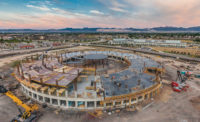Vertical Contruction Technology
A scanning robotic total station combines two functions.

In the 1950s, Ace Books began publishing Ace Doubles, which were two separate novels combined in a single volume. For example, a reader could read “Secret Agent of Terra” which ends at about the middle of the book. The reader could then close the book; do a head-to-toe flip of the volume; and there would be the cover of the second book, The Rim of Space.
The reader is happy because they get a twofer—two separate novels for the price of one (which was $0.40 back then). The two-novels-in-one book concept clearly provided great value to the avid reader.
That same kind of two-fer value proposition can also be seen in a new product for the vertical construction market. Available from Topcon Positioning Systems, the GTL-1000 is a compact scanner integrated with a fully-featured robotic total station, offering a site manager a dual-function instrument designed to complete a layout and scan on a single set-up. The data can be processed, mapped, and provide construction verification.
“The key benefit that got me most excited by combining layout and laser scanning into one device is placing that device in the right person’s hands,” says Taylor Cupp, technologist with M. A. Mortenson Co., Minneapolis. “On our projects, that is the layout professional—now we can empower them to not only do layout, but also capture what is built for quality control. It’s very beneficial because the person that knows how they’ve set up the job in terms of control points and those kinds of things can be the one to do that capture and get it as accurate as possible with one device.”

“As-Built” Model
Topcon describes it as a first in the industry that all work-flow components are integrated and provides users with a live, “as-built” model of projects, allowing the contractor to identify and rectify any discrepancies.
“Our field engineering team has expressed interest in a product like the GTL-1000 for many years—a product that allows them to survey and scan within the same workflow and not have to spend time in the office registering scan data,” says Paulina Acosta, senior applied technology specialist with Rogers-O’Brien Construction, of Dallas. “Each point cloud is geo-located before you leave the field. This makes them feel confident that the point clouds will be correctly positioned to our 3-D models, without the need for visual alignment or the need to return to the field to acquire more data in order to make the registration work.”
Nick Salmons, principal laser scanning surveyor at Balfour Beatty Construction of London says: “The robotic scanning solution will increase productivity on site by accelerating the construction process and identifying design challenges more efficiently than traditional methods.”
Salmons also says it will benefit the industry as a whole by “reducing cost and program duration, for both clients and contractors alike.”

Activation
The system is designed so the user can initiate a scan with the press of a single button. A full-dome 360-degree scan can be created in a few minutes, according to Ray Kerwin, Topcon director of global product planning. “More traditional systems and methods take considerably longer,” Kerwin says. “So, depending on the job site conditions, a contractor can get in and out quicker and thus minimizes safety concerns.”
A benefit Acosta likes: “We liked the ability to take individual as-built points with the GTL-1000 after it completes a full scan. This is helpful when you are trying to ensure that you captured the center point of a sleeve or a structural connection. These points appear in the point cloud after they are processed and eliminate the time spent by our 3D modelers trying to determine the positioning of specific items in a point cloud.”
The scanner is used in combination with ClearEdge3D Verity, a software tool designed to automate construction verification.
“The seamless integration of the GTL-1000 and Verity creates a complete package that is perfect for construction verification using 3-D modeling techniques,” Kerwin says. “The result is a system that offers full-dome scanning which can quickly capture duct work, columns, beams, girders, flaps, penetrations, and structural steel. It helps to improve quality assurance, providing clear visual indication of construction-quality heat maps to minimize the effects of mistakes before they become expensive problems.”
The system is designed to build upon proven prism tracking and accuracy that allows operators to establish points in most construction environments. The product includes on-board MAGNET Collage field software designed to process the data and offer real-time field-to-office connectivity.

Ready to Go
A key productivity benefit of the scanning robotic total station is that the site engineer requires no additional training and does not need to rely on outside scanning services. The new system is designed to take what was previously a rather lengthy, specialty process and compress all the steps, reducing the overall verification time.
The GTL-1000 was originally tested in the field by the infrastructure group Balfour Beatty.
“In our use and testing, we have found that the robotic scanning solution will increase productivity on site by accelerating the construction process and identifying design challenges more efficiently than traditional methods,” Salmons says. “We are delighted to have collaborated with Topcon over the last 12 months to trial this new tool, which will significantly benefit the industry as a whole; reducing cost and program duration, for both clients and contractors alike.”
The benefits of the combined scanning robotic total station are also said to extend to subcontractors, who can share the verification data, meaning all parties are working from the same construction-quality heat maps. For example, the first electrical ducts and conduits can often cause problems, as alterations can often occur that go unnoticed. With Topcon’s new system, the speed at which everybody working on the job can understand mistakes means the effects can hopefully be minimized before they become expensive problems.
As efficiency becomes increasingly important in the market, time cannot be wasted and mistakes cannot be tolerated. Clearly, the demand for quick construction verification is on the rise, which supports the need for new technologies that can help. W&C
Looking for a reprint of this article?
From high-res PDFs to custom plaques, order your copy today!






